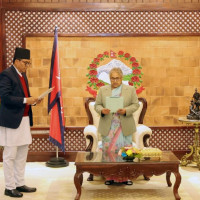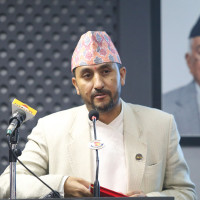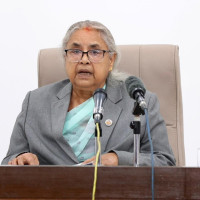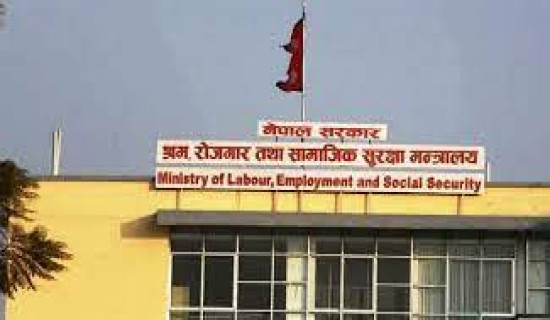- Tuesday, 16 December 2025
Kathmandu temperature rises by 1.6C in 2 decades
By Indira Aryal
Kathmandu, Apr. 30: The average maximum air temperature in the Kathmandu Valley is found to have increased by 1.6 degrees Celsius in the last two decades. Experts warned that the valley is likely to face the brunt of the urban heat island effect (UHI) more than anywhere in the country. UHI means the city or metropolitan area that is significantly warmer than its surrounding rural areas due to human activities.
The annual average maximum temperature in Kathmandu from 1991 to 2020 was measured at 26.0 degrees Celsius, while the maximum temperature between 1971 and 1990 was 24.5 degrees Celsius and the annual average temperature between 2001 and 2020 was 26.1 degrees Celsius. This means the maximum temperature in Kathmandu has increased by 1.6 degrees Celsius in the last 20 years.
According to the Department of Hydrology and Meteorology (DHM), the maximum temperature in April in Kathmandu has been increasing by 1.7 degrees Celsius in the last 20 years. March, April and May are the hottest months. The average temperature from 1968 to 2021 was measured at 27.9 degrees Celsius, from 1991 to 2020 measured at 28.6 degrees Celsius, from 1971 to 1990 measured at 27.0 degrees Celsius and from 2001 to 2020 measured at 28.7 degrees Celsius.
Dr Indira Kandel, the Senior Divisional Meteorologist at Climate Change Analysis Section under the DHM, said the average last two decades (2001-2020) maximum temperature is is higher than the average of 1971 - 1990 by 1.6 degrees Celsius. The Annual maximum temperature increases at the rate of 0.053 degrees Celsius per year. So we can say Kathmandu is warming. The warming is accelerated partially by the UHI effect.” Dr Kandel said.
That means the denizens have to face more problems in the coming days due to rising temperature, she said.
There are 20 meteorological stations in Nepal. Most of the stations showed that maximum temperature measured above the average temperature this year, she said.
The average annual maximum temperature of whole Nepal has risen by 0.056 degrees Celsius, according to a study conducted by the DHM.
The impact of global warming has started to be seen in developing countries like Nepal but global warming alone is not to blame.
The UHI effect, mainly due to unplanned development, growing industrialisation such as brick kilns, vehicle emissions and deforestation are some of the causes for rising temperature in city areas including Kathmandu, Dr Kandel said.
Madhukar Upadhya, a climate change expert, said that winter was warm this season, especially in Kathmandu. The spring season should be a bit long but this time, it was quite short. “Temperature started rising within a week after the end of the spring season this time. There was no precipitation in January and February which could also be a reason for the rising temperature.”
Dr Dharma Raj Uprety, Thematic Lead, Climate and Resilience at Practical Action, South Asia Regional Office, said that this year’s March has been recorded as one of the hottest months in 122 years in South Asia. A heatwave warning has already been announced for many states of India, including Rajasthan, Delhi, Haryana, UP and Odisha, as parts of these states recorded temperatures above 45 degrees Celsius and the impact can be seen in Nepal as well.
The rise in the temperature was expected because of an imbalance in the global weather pattern affecting everywhere and we are not exceptional, Upadhya said.
The maximum temperature in Kathmandu has been recorded at 33 degrees Celsius so far but if there will be no rainfall, the temperature could rise above the normal level, Upadhya said.
Uprety said, “Many parameters have been changing in the last 30 and 50 years.” In the last three days, four stations in the Terai recorded above 40 degrees Celsius and 20 recorded above 30 degrees Celsius. A heatwave is announced when the temperature remains above 40 degrees for two or more consecutive days in the Terai and the temperature above 30 degrees and below 40 degrees for two or more days in hilly areas.
According to an ongoing temperature analysis led by scientists at the NASA's Goddard Institute for Space Studies (GISS), the average global temperature on Earth has increased by at least 1.1 degrees Celsius (1.9 degrees Fahrenheit) since 1880 but in the South Asian context, it has been rising by 1.86 in the last 122 years, making us more vulnerable, Dr Upreti said.
According to the Climate Change Analysis Report of DHM, surface air temperature trends in the valley for 2011-2017 showed that the majority of the agricultural land in the valley has been turned into an impervious surface layer, drastically altering the valley's landscape. The climatic and weather conditions of the valley have changed dramatically over the last few decades as a result of rapid urbanisation.
Rapid urbanisation, and fluctuations in climatic parameters are recurring phenomena in the valley, because of which the concerned organisation should concentrate on developing a climate change adaptation plan to deal with potential climate variability extremes, which could reduce the magnitude of economic, social, and human losses.

















